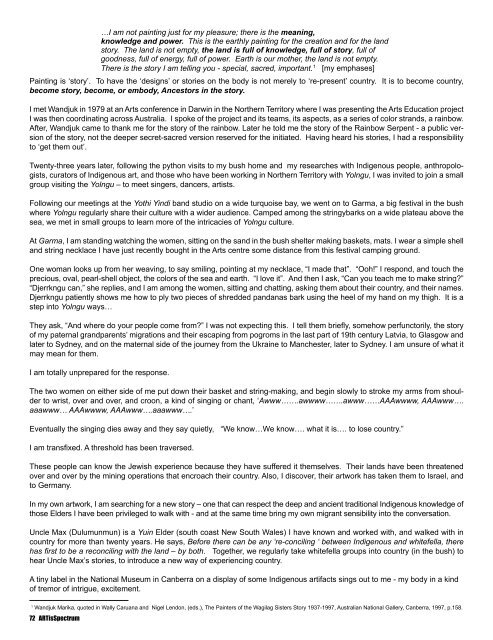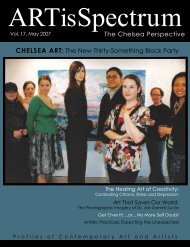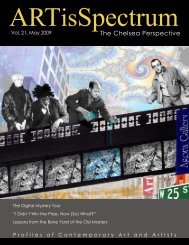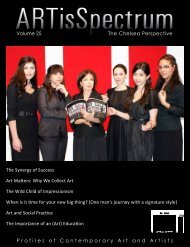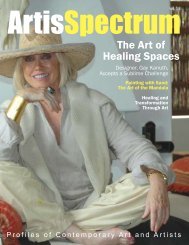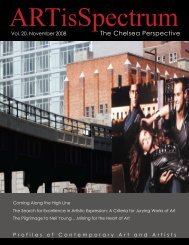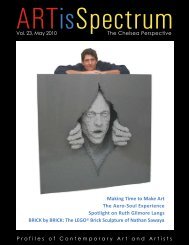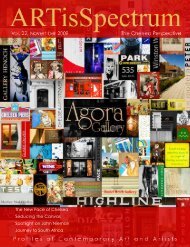Download PDF - ARTisSpectrum
Download PDF - ARTisSpectrum
Download PDF - ARTisSpectrum
- No tags were found...
You also want an ePaper? Increase the reach of your titles
YUMPU automatically turns print PDFs into web optimized ePapers that Google loves.
…I am not painting just for my pleasure; there is the meaning,knowledge and power. This is the earthly painting for the creation and for the landstory. The land is not empty, the land is full of knowledge, full of story, full ofgoodness, full of energy, full of power. Earth is our mother, the land is not empty.There is the story I am telling you - special, sacred, important. 1 [my emphases]Painting is ‘story’. To have the ‘designs’ or stories on the body is not merely to ‘re-present’ country. It is to become country,become story, become, or embody, Ancestors in the story.I met Wandjuk in 1979 at an Arts conference in Darwin in the Northern Territory where I was presenting the Arts Education projectI was then coordinating across Australia. I spoke of the project and its teams, its aspects, as a series of color strands, a rainbow.After, Wandjuk came to thank me for the story of the rainbow. Later he told me the story of the Rainbow Serpent - a public versionof the story, not the deeper secret-sacred version reserved for the initiated. Having heard his stories, I had a responsibilityto ‘get them out’.Twenty-three years later, following the python visits to my bush home and my researches with Indigenous people, anthropologists,curators of Indigenous art, and those who have been working in Northern Territory with Yolngu, I was invited to join a smallgroup visiting the Yolngu – to meet singers, dancers, artists.Following our meetings at the Yothi Yindi band studio on a wide turquoise bay, we went on to Garma, a big festival in the bushwhere Yolngu regularly share their culture with a wider audience. Camped among the stringybarks on a wide plateau above thesea, we met in small groups to learn more of the intricacies of Yolngu culture.At Garma, I am standing watching the women, sitting on the sand in the bush shelter making baskets, mats. I wear a simple shelland string necklace I have just recently bought in the Arts centre some distance from this festival camping ground.One woman looks up from her weaving, to say smiling, pointing at my necklace, “I made that”. “Ooh!” I respond, and touch theprecious, oval, pearl-shell object, the colors of the sea and earth. “I love it”. And then I ask, “Can you teach me to make string?”“Djerrkngu can,” she replies, and I am among the women, sitting and chatting, asking them about their country, and their names.Djerrkngu patiently shows me how to ply two pieces of shredded pandanas bark using the heel of my hand on my thigh. It is astep into Yolngu ways…They ask, “And where do your people come from?” I was not expecting this. I tell them briefly, somehow perfunctorily, the storyof my paternal grandparents’ migrations and their escaping from pogroms in the last part of 19th century Latvia, to Glasgow andlater to Sydney, and on the maternal side of the journey from the Ukraine to Manchester, later to Sydney. I am unsure of what itmay mean for them.I am totally unprepared for the response.The two women on either side of me put down their basket and string-making, and begin slowly to stroke my arms from shoulderto wrist, over and over, and croon, a kind of singing or chant, ‘Awww…….awwww…….awww……AAAwwww, AAAwww….aaawww… AAAwwww, AAAwww….aaawww….’Eventually the singing dies away and they say quietly, “We know…We know…. what it is…. to lose country.”I am transfixed. A threshold has been traversed.These people can know the Jewish experience because they have suffered it themselves. Their lands have been threatenedover and over by the mining operations that encroach their country. Also, I discover, their artwork has taken them to Israel, andto Germany.In my own artwork, I am searching for a new story – one that can respect the deep and ancient traditional Indigenous knowledge ofthose Elders I have been privileged to walk with - and at the same time bring my own migrant sensibility into the conversation.Uncle Max (Dulumunmun) is a Yuin Elder (south coast New South Wales) I have known and worked with, and walked with incountry for more than twenty years. He says, Before there can be any ‘re-conciling ‘ between Indigenous and whitefella, therehas first to be a reconciling with the land – by both. Together, we regularly take whitefella groups into country (in the bush) tohear Uncle Max’s stories, to introduce a new way of experiencing country.A tiny label in the National Museum in Canberra on a display of some Indigenous artifacts sings out to me - my body in a kindof tremor of intrigue, excitement.1Wandjuk Marika, quoted in Wally Caruana and Nigel Lendon, (eds.), The Painters of the Wagilag Sisters Story 1937-1997, Australian National Gallery, Canberra, 1997, p.158.72 <strong>ARTisSpectrum</strong>


